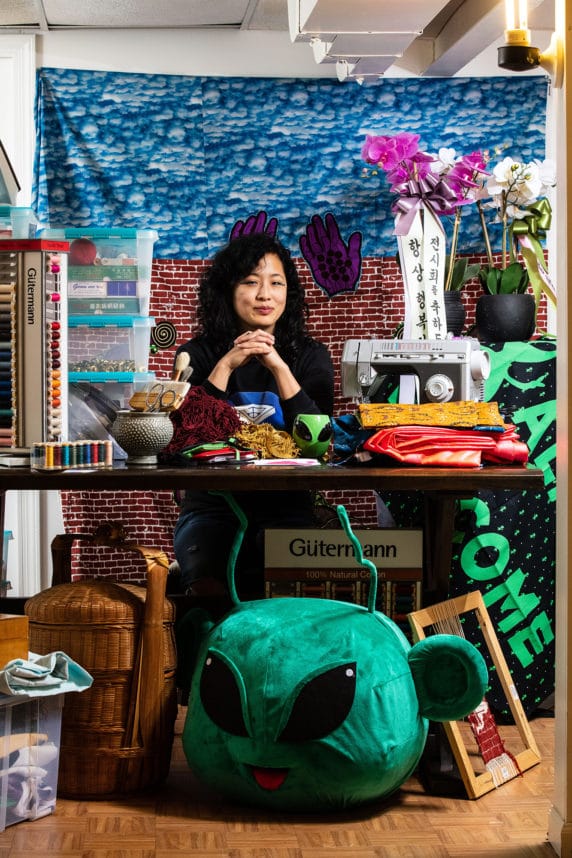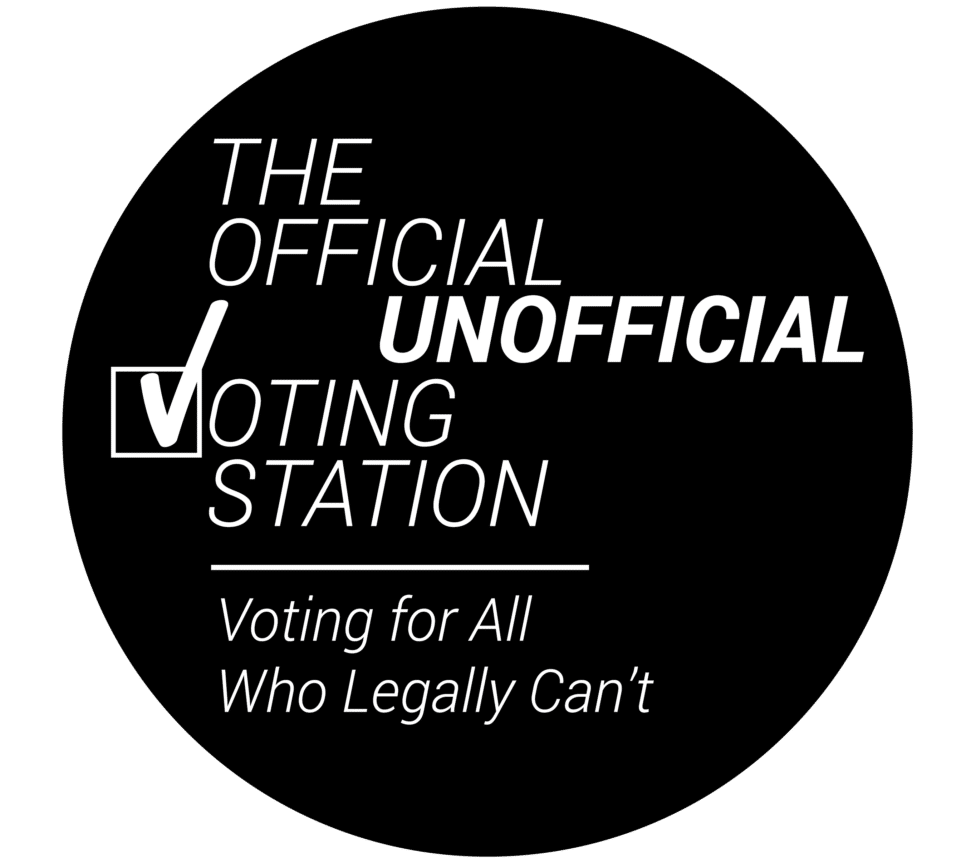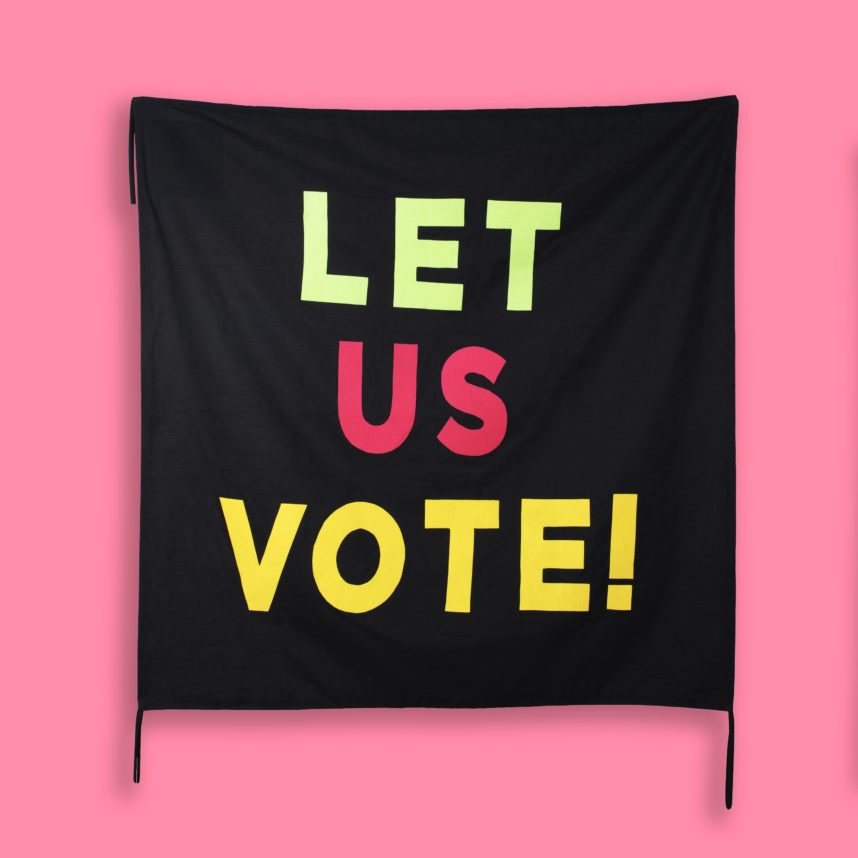 Photo courtesy of the Skirball Cultural Center
Photo courtesy of the Skirball Cultural Center The polls are open and not only are the ballots coming in, we get to see the tally practically in real time. It’s still too early to call this race, but Democratic challenger Joe Biden has opened up a substantial lead over President Donald Trump. Just as illuminating for the purposes of a unique online exhibition at the Skirball Cultural Center, a majority of people casting ballots believe that all residents of the United States, including noncitizens, should have the right to vote.
No, these votes won’t actually count toward determining the next occupant of the White House or in setting or changing policy. But through her interactive exhibition, “The Official Unofficial Voting Station,” on display online through Nov. 30 at Skirball.org, artist Aram Han Sifuentes has another goal in mind: raising awareness and generating discussion of issues around what is considered a fundamental American democracy.
“If people can vote, they should definitely exercise that right,” Sifuentes told the Journal. “The part that never makes it into many conversations is that there is such a big percentage of people who are ineligible to vote. I’m creating this project to make disenfranchised people visible and to make voices and opinions visible.”
By visiting the website, participants learn about the approximately 92 million people in the United States who were not legally eligible to vote in the 2016 election, according to the U.S. Election Project and the Census Bureau. These include youth younger than 18, noncitizens, incarcerated or formerly incarcerated people (in some states), residents of U.S. territories (who are permitted to vote in the primaries) and people who don’t have I.D.s. “Isn’t voting meant for all?” one graphic in the exhibition asks rhetorically.

Within the boundaries of Sifuentes’ exhibition, it most certainly is. By clicking on the enormous “Everyone Can Vote Here” tab underneath the “Who Can’t Vote in the U.S.” graphic, visitors are taken to a playful neon-lit ballot where they can mark their choice for president and weigh in on whether they feel that legally barred populations should be allowed to vote. Should the voting age of 18 be lowered, the ballot asks. If so, to what age? A different page enables visitors to see how the tally is going and what people are saying.
“The part that never makes it into many conversations is that there is such a big percentage of people who are ineligible to vote. I’m creating this project to make disenfranchised people visible and to make voices and opinions visible.” — Aram Han Sifuentes
The artist has her own views on most of these questions, but “The Official Unofficial Voting Station” offers no leanings or partisan views. “It is the most important act I can do to protect, change and champion my fellow Americans,” reads one response. “Only U.S. citizens should vote,” offers another.

Sifuentes admitted that some of the rhetoric could become angry, but she has not yet needed to stifle any voice.
“I had a lot of back and forth with my web designer about that,” she said. “Initially I said, ‘I want it uncensored so everything could be there.’ He said, ‘With the internet, there are a lot of bots and trolls and we should have a way to mediate some of it.’ There have definitely been some statements I don’t agree with, but they’re not ones that I think cross the line.”
When she first developed the project, Sifuentes was among the disenfranchised. A native of South Korea, she came to the United States when she was 5. She was not yet an American citizen during the 2016 election, when so much of the rhetoric centered around immigration policy.
“We’ve seen that play out where it was like, ‘Whoever is going to win is really going to greatly impact immigration in this country and our safety,’ and, of course, we are definitely seeing that play out in this moment,” Sifuentes said. “I sort of know the response so far to the project more than engagement with project itself. It’s more the political landscape that continues to surprise me and throw me off.”
After their ballots have been cast, exhibition participants can a request a free “Voted Despite the System” justice kit, which includes a checklist of action items, a poster and three specially designed “Voting for ALL” stickers designed by Sifuentes and Ishita Dharap. As a result, during this election season, you can get in on the fun by sporting a “Voted Despite the System” sticker alongside — or perhaps instead of — the popular “I voted” sticker.

“The Official Unofficial Voting Station” originally was configured to be part of a multi-stage indoor exhibition at the Skirball. When the COVID-19 pandemic forced arts institutions throughout the nation to close their doors, Sifuentes and the Skirball staff reconfigured the project to make it the Skirball’s first ever virtual exhibition. That transition took some maneuvering, but the logistics weren’t insurmountable, according to Skirball Assistant Curator Laura Mart.
“We really pride ourselves on being a place of gathering,” Mart said. “In the pre-COVID world, we were focused on the on-campus experience. But in this time that we can’t be together, it’s important that we find a way to present meaningful content and conversation digitally. One of the really cool things about the digital experience, is that it allows us to reach people who may not have been able to physically visit Skirball for a variety of reasons.”
“COVID has dashed many dreams,” added Skirball President and CEO Jessie Kornberg, “but in this instance, I think the way in which the exhibition has evolved to still allow participation in a safe way online obviously loses the in-person experience but gains a kind of access to this message and this creation that we would never have been able to accomplish at the museum physically.”

Even with its gallery spaces shuttered, the Skirball has programmed multiple events tying into the themes of “The Official Unofficial Voting Station” and the 2020 election. Two online workshops held over the summer during which Sifuentes taught participants to create their own fabric protest banners were sold out. An upcoming discussion of the 2020 California ballot measures with the League of Women Voters is sold out as well (but will be posted on YouTube). The Skirball’s Ahmanson Hall also will be a voting center from Oct. 23 through Election Day.
In addition, “The Official Unofficial Voting Station” will have a physical presence, just not at the Sepulveda Boulevard campus. In 2016, Sifuentes and artistic partners developed voting stations at more than 25 unique locales across the country and in Mexico. For 2020, there will be pop-up stations as well as concurrent long-term exhibitions at locations in Denver, Milwaukee, Philadelphia and South Korea.
The exhibition concludes Nov. 30. Visit the website.





















 More news and opinions than at a Shabbat dinner, right in your inbox.
More news and opinions than at a Shabbat dinner, right in your inbox.